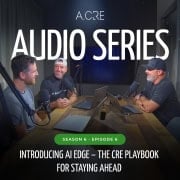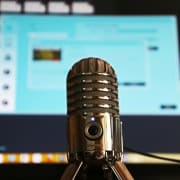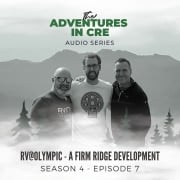Modeling Like a Deal Seasoned Pro – Accelerator 3 | S5E3
In this episode of the Adventures in CRE Audio Series, Spencer Burton and Michael Belasco revisit a popular topic: Modeling Like a Deal Seasoned Pro. In conjunction with the launch of the Accelerator 3.0, they reflect on the origins of the Accelerator program and how it was designed to fill a gap in real estate financial modeling education.
They share personal stories of learning through trial and error, highlighting the importance of case-based, practice-driven learning for mastering real estate financial modeling. Spencer and Michael then dive into what’s new with Accelerator 3.0, including AI integration, networking features, accountability tools, and expanded opportunities for collaboration through case competitions and events.
Listen, watch, or read to discover how the Accelerator 3.0 takes real estate education to the next level!
Modeling Like a Deal Seasoned Pro – Accelerator 3
Or Listen to this Episode
Resources from this Episode
Episode Transcript
Michael Belasco (00:08):
All right. Welcome back to another episode of the A.CRE podcast series. What is this, season five?
Spencer Burton (00:14):
Yeah, season five. That’s right.
Michael Belasco (00:15):
All right, season five. We are going to do an episode that we’ve done before, Model Like a Deal Seasoned Pro. And the reason we’re doing it now is in conjunction with the launch of the Accelerator 3.0. We’re going to talk to you about historically why we launched the Accelerator, talk to you more about the key skills you need, and also what’s new in the Accelerator. And I’m going to kick this off by asking you, Spencer, a question bringing us back to the foundations of this program. Why did we decide to launch the Accelerator program initially?
Spencer Burton (00:47):
Yeah, so this launched officially 2019, so we’re going on, this is our sixth year. You don’t learn this skill the way that you learn most other things in real estate. And you and I concluded that very early on. In fact, when we were in grad school, there was this moment where we were vociferously absorbing any content that we could around real estate financial modeling because we had been told that this is the most important skill when you come out of school. If you don’t have that on day one, someone else is going to get the job. And because we come from atypical backgrounds, we knew that this was our differentiator. However, you don’t learn this skill in a semester course or in a weekend boot camp. That was very clear. And so we’d concluded that you learn it on your own through practice, through iteration, the same way that you learn to play, say, an instrument. In fact, you and I were having this discussion over 10 years ago, and you were describing, Michael’s a phenomenal guitar player.
Michael Belasco (01:48):
In another life.
Spencer Burton (01:49):
In another life. He was in a band and all that. And he was explaining to me how he learned to play the guitar. And he’d sit in a dark room and he’d listen to-
Michael Belasco (01:57):
Jimi Hendrix.
Spencer Burton (01:57):
Jimi Hendrix.
Michael Belasco (01:58):
Amongst many others.
Spencer Burton (01:59):
Amongst many others. And he would try to replicate how they played. And then I’m sure you had some instruction around chords and what do you call it when you pluck or strum?
Michael Belasco (02:09):
Melodies and scales.
Spencer Burton (02:10):
Scales and all that.
Michael Belasco (02:11):
Very little. All of it was kind of what you’re talking about.
Spencer Burton (02:12):
You can tell I don’t play the guitar. But the point is, you learn certain skills like these through repetition, through inspiration, watching other people and trying to replicate what other people do, but ultimately you create your own music and your own style. And pair that with an internship I had when I was in school where one of the most valuable things I had was there was this phenomenal financial modeler at the company, and I would love going over to his desk and watching him with his dual monitors model, mouse over there in the trash can.
Michael Belasco (02:47):
This is the Hendrix of financial.
Spencer Burton (02:48):
This was the Hendrix of financial modeling. And I would then go back to my desk and I’d try to, oh, I saw this and I saw that. And that actually is the precursor to our Watch Me Build. That’s a whole other topic. The point is, you learn real estate financial modeling through repetition, through practice, through having some inspiration and having some instruction, but generally on your own. And so fast-forward, Michael and I have great jobs. The A.CRE website is growing and we’re getting email after email after email, “Hey, where do I start to learn this? What model do I use first?” And we would provide some guidance, but we were hesitant to create a course, because we don’t believe in the traditional way of learning this. Go ahead.
Michael Belasco (03:35):
Let me add real quick, because we have firsthand direct experience of that not working well for us and for many of our classmates at school. We did weekend boot camps, we’ve had different programs. All of them were with poor results for everyone involved. Just imagine having a room with an instructor. You have savants in finance, you have guys coming in out of the construction field, you have people in unrelated industries coming in, and one instructor has to teach an entire room all with varying skills. Who do you teach to?
Spencer Burton (04:10):
Lowest common denominator. That’s who you teach to.
Michael Belasco (04:13):
Right. So it never worked out well. All of those programs, all of those courses.
Spencer Burton (04:16):
There were a waste of money. I remember this professor from a big school who I won’t name, guest professor came in for this weekend boot camp about waterfall modeling, complete waste of time. With all due respect to that.
Michael Belasco (04:31):
And you feel the energy, because we really wanted to learn this. It was very important. And we all came out of there more confused than we were going in.
Spencer Burton (04:37):
We paid good money for that. Anyway. So that was our view on it. Fast-forward, A.CRE has grown. We’re getting a lot of requests. “Hey, how do I learn this?” And so Michael and I, we sat down with one another and we said, “Okay, if we were to learn this again, how would we learn it?” And the first point is we would learn it the same way, iteration, case study, practical applications, but if we had someone that could help us accelerate that process, what would that look like? From that came the Accelerator program. So that’s the why. This is not a course, although it is a series of, we call them courses, segments, what have you. It’s a program. It’s meant to accelerate the process of mastering this skill. You can learn this on your own. We did. But it took us years. The Accelerator is meant to accelerate that process down to you really focus several months and you’ll be at the same level of mastery that it took us years to get to.
Michael Belasco (05:27):
Yeah. So you have all that support that we wish we would’ve had, and the step-by-step process where you’re not having experiences of sitting, for me, it was this final exam for one of our professors and I had this big development model and I couldn’t find the circular reference. My first exposure to circular references. And I stayed up till the sun came up trying to figure that. You won’t have any of that. It will be us with the years of experience we’ve had in the industry, guiding you right into success.
Spencer Burton (05:54):
Yeah. So let’s now understand the Accelerator a bit more. For those who maybe are unfamiliar with it, its foundation is in case-based learning. Okay? So every module, course, if you will, are grounded or it’s framed around a case. Each one of these courses, these modules build on top of one another. So we start with direct cap. It’s like you’ve got to build to a stabilized NOI. You’ve got to figure out how to produce a cap rate. And with your NOI and cap rate, you can get a direct cap value. We move to the DCF, how to value based on a string of cash flows out into the future and the present value of those cash flows. Those are some foundational finance concepts that are likewise key to real estate. But then we start moving into really the meat of financial modeling. We have the course, which I would argue is the most important component of the core curriculum of the Accelerator, and that is the anatomy of the real estate DCF.
(06:53):
That’s the framework for building dynamic real estate financial models, inputs, calculation modules, outputs, investment cash flows, operating cash flows, reversing cash flows at the property cash flow level, contributions and distributions at the partnership cash flow level, and that then blends into key risk and return metrics, which those cash flows that you produce in your dynamic models result in some metrics. And those metrics help you make investment decisions. So that’s how the Accelerator starts. And then we build on from that with income statements, modeling leases. We then roll in debt. Notice that debt comes almost 10 modules in. That’s on purpose, because real estate cash flow modeling starts with unlevered cash flows. You introduce debt, it introduces a complexity that’s unnecessary. But I remember early on, I didn’t understand that.
Michael Belasco (07:39):
Yes.
Spencer Burton (07:40):
And so I’m like, well, what about my partnership? What about my waterfall model cash flows or what about my debt cash flows?
Michael Belasco (07:45):
Because it was presented all-
Spencer Burton (07:46):
All together, right?
Michael Belasco (07:47):
Yeah.
Spencer Burton (07:48):
And so this is very much a building block. And by the way, every one of those modules has a case study with a real-world task assigned to it that you and I have done.
Michael Belasco (07:58):
And based on our real-world scenarios, us showing up to institutional shops where we worked at and sitting in our offices with our direct reports and going through these things.
Spencer Burton (08:11):
So that’s the foundation of the Accelerator. So think of the Accelerator 1.0 was that core curriculum and that case-based learning with a building blocks approach. And it was a phenomenal success, right? When we eventually launched it, almost universal positive feedback. Feedback like, “I learned more from that Accelerator than I did from my masters in real estate program,” which we appreciate the comments.
Michael Belasco (08:37):
Which we still get.
Spencer Burton (08:38):
And we still get those. But what happened is when you launch a product like this and you get so much adoption quickly, is you start learning. And so the first thing we learned is it’s great to have a core curriculum. It’s great to get people to basic proficiency. I say basic proficiency. You take the core curriculum at the end of it, you can add value on day one as an analyst or associate. That’s the reality.
Michael Belasco (09:03):
You’re doing partnership modeling, you’re doing development, you’re doing very complex stuff, a lot of what you’ll need to do to hit the ground running right out of the gate.
Spencer Burton (09:11):
Yeah. But we learned that there are a lot of advanced concepts that you don’t use on a day-to-day basis, but you will use from time to time in your career that needed discussion. And so over three years, we built hundreds actually of lessons, tutorials for advanced concepts, catch-ups and claw-backs, irregular contributions, the nuances.
Michael Belasco (09:36):
Different debt structures, even in development between land loan, bridge financing, construction, debt [inaudible 00:09:43].
Spencer Burton (09:42):
Carried land plays, you did, yeah. So these sort of advanced concepts that, again, you don’t see on a day-to-day basis, but you will, were introduced as part of initially in the 1.O, these advanced modules, which weren’t organized very well.
Michael Belasco (09:57):
No, it was slew. It was great. It was great content, but it was not as accessible as it could have been, I think, was really the-
Spencer Burton (10:04):
So the 2.0, how did we solve that?
Michael Belasco (10:05):
Well, there’s a lot of things that happened. First we created, I’d drawing blank on the word.
Spencer Burton (10:11):
Specialty endorsements.
Michael Belasco (10:12):
Yeah, the endorsements, yes. So the way we solved that was we created the endorsements. So we organized all the extra content that was there into you have partnership, you have debt, you have, what are some of the other?
Spencer Burton (10:27):
Development. You have portfolio modeling.
Michael Belasco (10:30):
So that was a way to basically unlock additional value in basically like how we did the core, which was we kind of walked you step-by-step through the process at the macro, at the macro and micro level for how to get proficient in the basics. And then we guided you through whether it, again, was development or debt into more nuanced and sophisticated concepts, which could further help you hit the ground running.
Spencer Burton (10:54):
But the point was, those endorsements are meant to augment the core. The cor continues to be our flagship. The core continues to be Michael and I saying to you, “This is what you need to know to add value in your firm.” With the endorsements being, hey, if you’re at a development shop, taking the development endorsement would be valuable. If you’re at an LP, taking the partnership cashflow. You’re a real estate private equity firm, taking the partnership cashflow endorsement would be valuable. So that was the 2.0. We also, in the 2.0, improved our forums and that actually became a Q&A.
Michael Belasco (11:26):
We shifted off of a third party.
Spencer Burton (11:28):
And we shifted the third party to our own proprietary platform. That’s true. So we had more control over the experience, better user experience, and much faster platform too, the 2.0.
Michael Belasco (11:36):
Yeah, much slicker.
Spencer Burton (11:37):
Much slicker, yeah.
Michael Belasco (11:39):
It’s a lot of back-end stuff that I think people don’t realize, which got solved just by moving onto our own server.
Spencer Burton (11:46):
And so that brings us to the 3.0. We had three years with the 2.0, graduated I think another thousand people on that platform. And there were a few things that, again, we learned through the first three years or the second three years, and now as we look forward to the next three years. The first is AI has hit the scene, and we wanted to make sure that we could begin to deliver learning around AI. We also wanted to leverage some of the AI capabilities to enhance the learning experience. That was one. The second is we heard from our users, from our members, “I wish that there was more networking opportunities.” I mean, think about it. Those who take the Accelerator are coming out of the best schools in the world. They’re creative entrepreneurs. They’re working at some of the best, the biggest firms in the world, and our Accelerator members want to interact with one another in a more meaningful way.
Michael Belasco (12:47):
Yeah, and at this point in the career is great when most of our users are at the right moment where you’re all kind of at the same level to interact at that time. So we wanted to create that gateway to be able to do that.
Spencer Burton (12:59):
Yeah. So AI was one, networking was another. The third was around accountability.
Michael Belasco (13:05):
Yes.
Spencer Burton (13:06):
Right? And early on, Michael and I had this view, because we’re very goal-driven individuals. It’s like, if I’m going to do it, I’m just going to go do it. I don’t need someone to hold my hand, hold me accountable. Not all of us are that way. And there’s no disrespect for those who need a little bit of push, a little bit of help. All of us have bought a gym membership in January.
Michael Belasco (13:32):
Mine was in December.
Spencer Burton (13:35):
In December. There you go. And so the third was how can we bring some features that would help hold people accountable to meeting their goals in the accelerator? So those were, I’d say, would be the primary three thoughts that we had as we explored what we would do in the 3.0. There’s some ancillary things around events that’s interesting, around content.
Michael Belasco (13:55):
Yeah. And we have capabilities now with this new platform that we have to be able to do these things. There’s even concepts, while we haven’t rolled out any of these yet, but there’s the cohorts, there’s these gamification. Maybe even we’ll do these inter, within the Accelerators-
Spencer Burton (14:11):
We could do competitions.
Michael Belasco (14:12):
Case competitions. So there’s a lot of fun things. Back to that networking thing, I’ll even just opine on it.
Spencer Burton (14:19):
Yeah, please.
Michael Belasco (14:19):
It’s not really fully formed out, but getting different universities, different students from different universities to connect and form a team, there’s all these, and do case study competitions together, but with different people from it. But we have the capabilities now to do that. And this is a community, by the way. So I’m saying we have these capabilities, maybe somebody out there has an idea they want to present to us. I mean, we’re open. We just have this new platform now that allows us to create more of that community and connectivity, and so that’s a big value add for the entire user base.
Spencer Burton (14:53):
Yeah, so if you’re an existing Accelerator member, you have access to the 3.0. So all legacy members are grandfathered in with access to the 3.0, assuming you’re an active member. If you’re an inactive legacy member, you can renew and you’ll immediately have access to the 3.0. And for those who are new or perspective, what to expect from the 3.0, first off, a modern clean look. Even our 2.0 has gotten a little dated feeling. So this is a modern clean look. Some touch-ups on branding that feel nice.
(15:27):
It’s faster. And our 2.0 was pretty fast. This one’s faster. There are now some really cool networking features. You can private message anyone, including me and Michael. We may not check the private messages in the Accelerator, but you can private message the Accelerator team, the A.CRE team, any of the other Accelerator members, if that Accelerator member opens their profile to do so. You can see other Accelerator members, if that Accelerator member is public to the community.
(15:59):
And then we’ve got different boards. So we have this area called the Hub, where we share content on a daily basis that we think is valuable. Accelerator members can share jobs and career opportunities either at their firm or they’re hearing about. They can share it to a section. We’ll also share job opportunities that we come across. And so anyway, those are the networking tools. AI is throughout. On the back end, we use AI to make the platform more efficient and on the front end we use AI. Part of our accountability tools are actually powered by some AI things that we have. We’ve got a whole section now, we don’t call it an endorsement, although it is effectively an endorsement entire section called Apply AI, which launch had six modules. I’m committing to producing a new module every month going forward, at least for the next year, such that we have a critical mass of AI learning options.
(16:57):
And then on the event side, our AMAs are being wrapped into the Accelerator so it’s much easier to attend an AMA event. And then as we have partnerships with companies that want to do company information sessions, those would be housed on the Accelerator as well. So the 3.0, it’s exciting, what we have. And we look forward to your feedback over the next three years as we use this next iteration of the Accelerator.
Michael Belasco (17:24):
Yeah, again, we’re excited to have, there’s a lot of capabilities here too. So as this evolves and develops, we want to make this ultimately the best experience. So while we do have a lot of community features, there’s also a lot of privacy features too. If you want to go back to being in the dark and working clothing optional in your room and you want to do that, that’s cool too. But again, we think that we’re going to create a really great base, I would say, of a platform that allows for everything you got from 2.0 now with 3.0 and all these added capabilities. So again, we’re incredibly excited to be launching this and bringing this to everyone in our community.
Spencer Burton (18:04):
Yeah. With that, let’s finish this episode and we’ll move on to the next.
Michael Belasco (18:07):
Sounds good.
Announcer (18:10):
Thanks for tuning into this episode of the Adventures in CRE audio series. For show notes and additional resources, head over to www.adventuresincre.com/audioseries.
Frequently Asked Questions about Modeling Like a Deal Seasoned Pro (Accelerator 3.0)








